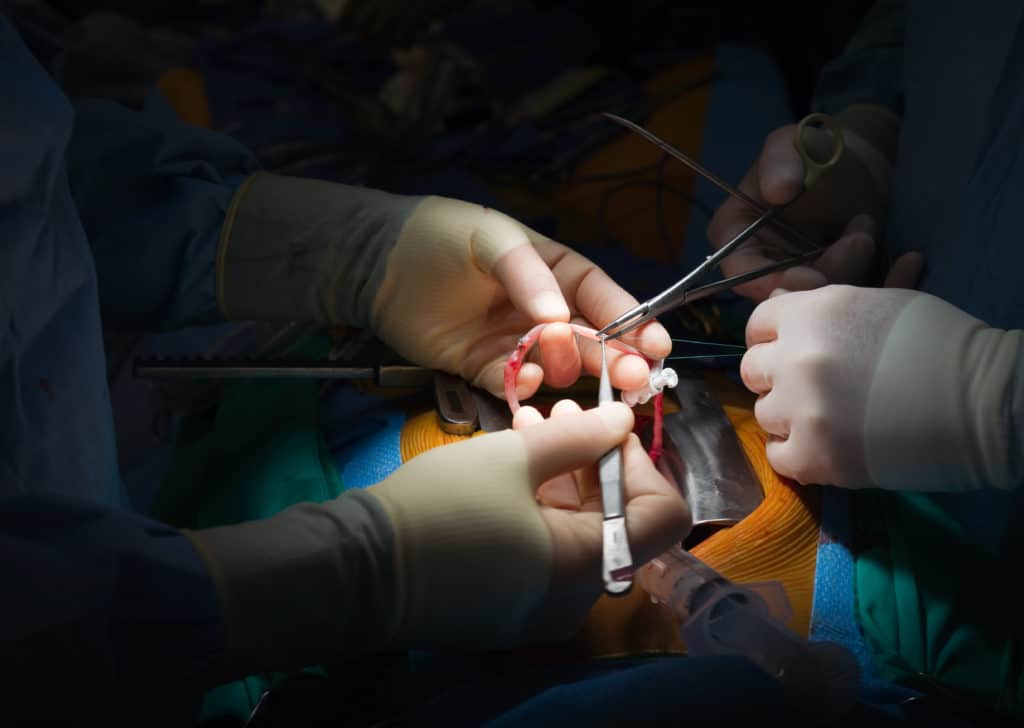Coronary Artery Bypass Surgery
Furring up and narrowing of the coronary arteries impairs blood supply to the heart muscle and causes symptoms, typically chest discomfort, which can affect quality of life and, in some cases, prognosis. Treatment always involves medication and in many cases patients are offered either angioplasty (using a stent) or coronary artery bypass grafting/surgery (CABG – pronounced “cabbage”) to improve the blood supply to the heart and relieve symptoms. The choice of treatment depends in part on the clinical situation, i.e. whether a patient has a stable pattern of symptoms, or if it is an emergency situation such as a heart attack, the extent and location of the narrowing in the coronary arteries, and, to a degree, patient preference. There will be situations where both bypass surgery and angioplasty/stenting are suitable options and these should be considered carefully, ideally in a multidisciplinary team meeting (MDT), where imaging specialists, general cardiologists, interventionists and surgeons can look at the data together and decide on the best way to proceed.
Conventional bypass surgery involves the placement of lengths of vein (typically the saphenous vein from the leg) or artery (the internal mammary artery which lies on the undersurface of the chest wall, or the radial artery which is located in the forearm) to bypass the blockage in the coronary artery. One end of the length of vein is attached to the main blood vessel from the heart, the aorta, and the other end is attached to the coronary artery beyond the blocked segment; the internal mammary artery already arises from a large vessel off the aorta and so it is attached directly to the coronary artery. The internal mammary artery has been shown to stay free from obstruction more successfully than vein grafts, and so every effort is made to use this as a bypass graft with additional vein bypass grafts as necessary. The traditional operation, which has been refined over more than 60 years, involves making an incision, known as a median sternotomy, through the breast bone at the front of the chest to gain access to the heart. During the procedure the heart is “put on bypass” using a heart-lung machine to support the circulation and oxygenate the blood whilst the heart is stopped for the surgery to be performed.
More recent advances include the use of “off-pump” surgery (Off Pump Coronary Artery Bypass, OPCAB) which avoids the need for a bypass machine, as the heart does not need to be stopped for the surgery to be performed; instead it is undertaken on a beating heart. The role of minimally invasive robotic surgery for cardiac conditions is another option for some patients.
Coronary artery bypass surgery is a major operation and most patients should expect to be in hospital for up to 7 days, with full recovery taking up to three months. Driving of private motor vehicles should cease for at least four weeks post-surgery, but the DVLA does not need to be notified. Drivers with vocational Group 2 licences are subject to different restrictions, and full guidance can be found via the DVLA.

Related links:
Symptoms - Chest Pain
Chest pain has a variety of causes, one of the most important of course being pain from the heart. Read more
Conditions - Coronary Artery Disease and
Angina
Coronary artery disease is the term given to soft fatty deposits or hard calcified plaques within one or more of the coronary arteries, the vessels which supply blood to the heart. Read more
Conditions - Heart Attack
Heart disease and diseases of the circulatory system are the leading cause of death in the UK, with one third of all deaths occurring from cardiovascular disease. Read more
Test - Coronary Angiogram
Coronary angiography, also called cardiac catheterisation, is a sophisticated test undertaken by an interventional cardiologist as a day case in hospital, which allows the doctor to obtain detailed information about the coronary arteries, and the extent and severity of any disease within them. Read more
Treatments - Coronary Angioplasty/Stent
Coronary angioplasty/stenting, also called percutaneous coronary intervention (PCI) or the balloon and stent procedure, is a treatment used to deal with tight narrowings in the coronary arteries that are affecting the blood supply to the heart. Read more